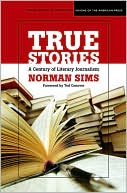This semester, as I’ve mentioned a few times, I’m taking a class on literary journalism. The first part of the semester has been devoted to understanding the development of literary journalism through two books I really enjoyed–True Stories by Norman Sims and The Gang That Wouldn’t Write Straight by Marc Weingarten. I was going to review these separately, but as I started to write I realized I liked them both for similar reasons and think that they complement each other as texts.

I researched literary journalism for my senior project last year, but couldn’t find any books that did as good of a job summarizing and explaining the movement as this book. True Stories takes what is an incredibly diverse and thought-provoking movement and manages to distill it down to its most salient points. Sims uses good examples and passages from famous texts to make each of his points, and profiles authors to explained larger social trends. The book walks a line between storytelling and textbook, but I think Sims’ voice is friendly enough that the book doesn’t get dry like many “history of a genre” books can be.
The Gang That Wouldn’t Write Straight is a history of just the New Journalism movement, focusing from the early 1950s through the mid 1970s. Similar to True Stories, Weingarten profiles many of the major writers–Tom Wolfe, Hunter S. Thompson, Joan Didion, Norman Mailer–by focusing on their work and their impact. He uses a ton of details, but I felt like those details were always relevant to what he was trying to describe. I actually gained more respect for Hunter S. Thompson as a journalist after reading about his work reporting for his book Hell’s Angels, something I didn’t think was possible.
Weingarten also did a lot of interviews for this book, getting face time with a ton of the most famous new journalist. I’m incredibly jealous of that, but also really impressed. The moments when authors reflect on their work or the impact of their work is very interesting to read.
Sometimes The Gang That Wouldn’t Write Straight gets a little name-heavy, talking about editors and founders and competitors and critics, which gets tough to follow. There were times when I just wanted Weingarten to get on with it and get back to the names I could recognize and would remember, not the ones that aren’t important to me. The book also peters out near the end, finishing more with a whisper than a bang. In some ways this makes sense–New Journalism never really ended, just sort of went out of vogue and lost the momentum it had during the heyday of the 1960s.
In any case, the combination of these two books is a good overview of an diverse movement in journalism. I enjoyed both of them in terms of their writing style and subject matter, and would recommend one or both for people interested in literary journalism.
Links to Enjoy:
- An interview with Norman Sims at Poynter Online
- A review of The Gang that Wouldn’t Write Straight from the New York Review of Books
- A Q&A with Marc Weingarten from metabistro.com
Other Reviews:
If you have reviewed this book, please leave a link to the review in the comments and I will add your review to the main post. All I ask is for you to do the same to mine — thanks!

Comments on this entry are closed.
OK, I’m curious but lazy. What is the defn of literary journalism? I instantly thought of Truman Capote and how In Cold Blood was the first of its kind. Maybe I’m totally wrong in thinking I heard that somewhere…
bkclubcare: There are a lot of semi-definitions, but I usually think of literary journalism as writing that relies on facts and factual events (as gathered by reporters), but written using the techniques and tools of fiction and storytelling (dialogue, description, scene setting, characters, etc.)
Lee Gutkind, one of the fathers of creative nonfiction said, “Ultimately, the primary goal of the creative nonfiction writer is to communicate information, just like a reporter, but to shape it in a way that reads like fiction.”
Honestly, it’s a new, emerging, forming sort of genre, so lots of people are still trying to figure out how to define it. I hope some of that helped though!
And yes, In Cold Blood is one of the earliest examples of literary journalism. It’s a classic that I definitely want to read.
Cool. I would think Tracy Kidder falls into this category. And I absolutely LOVED the Secret Life of Lobsters by Trevor Corson. Funny, how I can love nonfiction but HATE to read anything long in the newspaper.
Thanks for the definitions! I read In Cold Blood in high school and read it again before all those Capote movies came out a couple of years ago.
bkclubcare: I have House by Tracy Kidder sitting on my to read pile, I’d say he falls into the category for sue. And The Secret Life of Lobsters is one of the books we’re reading later in the semester for this class. I’m more excited to read it now!
It all really depends on the style — not all long newspaper writing is done well, so it can be hard to read. Ideally, I think newspapers should be more open to using literary techniques in long articles, where appropriate, but it’s something that’s slow to shift.